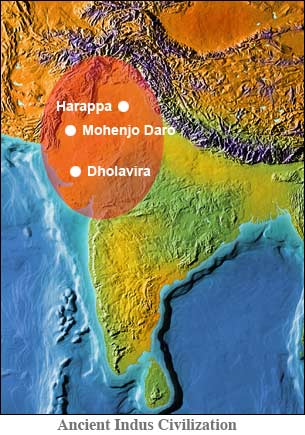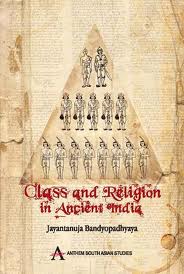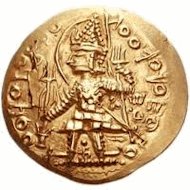The Ancient History of India

Early Man was Part of the ancient history of India.
The ancient history of India began more than 5,000 years ago, when tribes began to emerge along the Indus River in what is now modern day India and Pakistan. These social groups are known as the Indus River Civilizations and they greatly influenced the history of ancient India. The most famous Indus River Civilizations were called the Moheno-Daro, Harappa, and Lothal.
The people of the Indus Valley Civilizations lived simple lives. They worked with metal, developed their own form of writing, and they unknowingly shaped the ancient history of India. Somewhere between 2600 and 1900 BC, they developed useful stone tools, such as axes and spears. This era of invention in the ancient history of India is known as the Bronze age. India's ancient culture quickly developed, grew, and changed from here.
The Invasion of the the Aryans
Between 2000 and 1500 BC, Aryan people migrated into the Indus Valley Civilizations and dominated the social structure of the the indigenous people that were already there. They implemented new social structures that included a hierarchy, known today as India's Caste System. They also brought organized forms of religion with them.
Prior to their arrival, the early tribes primarily worshiped a Sun God and celebrated nature. These Aryan priests were a powerful group of people in the history of ancient India. These priests were called Bramhanas and they were self-proclaimed priests and they were held as the highest status in the new social hierarchy. This means that they were at the top of the caste system. This change to the previous simple social structure greatly influenced the culture and history of ancient India.

Ancient History of India - The Vedic Age
The era in which this hybrid culture emerged is referred to as the Vedic Age, or Iron Age. The Aryan people and indigenous people had socially merged into one culture. This era was a time of discovery and artistic creativity in ancient India history. People drew symbols and gave them an understood meaning. Music and dance developed during this age, and the popular religion known as Hinduism was born.
Essentially, Brahmanism developed into Hinduism and sacred texts were written in the ancient language of Sanskrit. These texts emerged during the history of ancient India. Because this took place so long ago, Hinduism is known as being the oldest surviving religion that is still regularly practiced today!
Religion in India developed further during the ancient history of India, after the Vedic Age began. Here religious belief systems, called Mahajanapadras, emerged in various areas of modern day India. Some of the most prominent early religions include Magadha; its basic principles eventually lead to the creation of two of India's most popular religions of Jainism and Buddhism.
Ancient History of India - The Era of Empires
The history of ancient India includes the rule of massive empires. Between 381 and 185 BC, almost all of India was under the rule of an empire called the Maurya Empire. The dominating Mauryan Empire was powerful and it emerged directly from the Magadha religion, which later developed into Jainism and Buddhism.
Alexander the Great left India during this time period, after fighting many battles. His battles left many areas of India weak and easy to to concur. The Mauryan Empire took advantage of these distressed areas of India. The Maurya Empire was the world's largest empire during its rule!
Eventually, the Mauryan Empire became so large that it could not rule its entire conquered territory, and so its reign over ancient India history came to an end. The empire basically fragmented into many smaller self-governed states called Middle Kingdoms. Things stayed this way for the next 1500 years and this time period was known as India's Classical period. This was an era where India saw little conflict, and had the largest economy of the ancient and medieval world. It was a time of discovery, art, and peace.
In the fourth century of the history of ancient India, most of the country was united under empire the Gupta Empire. The Gupta Empire's rule is also known as the Golden Age. During the Gupta Age, people began to truly value the importance of intellect and religious ideas. For the next several hundred years, this philosophy trickled into Southern India too.
The Chalukyas, Cholas, Pallavas, and the Pandyas were all rulers of regions of Southern India. During their rule, Indian civilization, administrative ideas, culture, and the religions of Hinduism and Buddhism spread to other countries in Asia. This is where ancient India history ends and the page in the history book concludes and we turn the page to discover Medieval India History.
Leave ancient India history to explore India's later history.
Visit our homepage to discover more of India
If you like our site and want to create your own around your favorite topic, check this out!




